Utah County Birders
Newsletter
February 2019
Contents
Monthly Meeting
Upcoming Field Trips
Captain's Log
Bird of the Month
Field Trip Reports
Printable Version
FEBRUARY MEETING:
Wednesday,
13 Fev
2019, 7:00 PM - at the
Monte L. Bean Museum.
Map to Museum
Our guest speaker will be Steve Van
Winkle. He recently took a trip to Africa to do some touring, hiking, and
humanitarian work, and he saw some pretty cool things while he was there. He'll
report on some of the birds he saw and what he did on that trip.
FIELD TRIPS:
2 Feb 2019 -
Gull Identification Clinic, presented by Cameron Cox at the
George S.
and Dolores Doré Eccles Wildlife Education Center. (by Farmington Bay)
We will meet at the Pioneer Crossing park & ride at 9am.
Click on this link to register. You need to register but it is FREE!
23 Feb 2019 - Delta Snow
Goose Festival: Trip Leader: Suzi Holt Meet at the Payson Walmart NE corner
at 7:30 am we will return in the afternoon sometime around 2:30 pm. It is a
sight to behold!!!
Utah County Birders
Captain’s Log: February
2019
Text and Photos by Keeli Marvel
Trip to Florida
Greetings
fellow birders! Welcome to the second month of 2019! This year is zooming by
fast.
So I have some minor success to report.
I spent a week in Florida at the beginning of the year. I had grand plans to
add lifers to my list left and right, but as per usual, life had its own
plans, and I got the flu mid trip and ended up only getting 2 of my targets.
On the bright side, if you are going to get the flu while traveling, I
recommend somewhere warm with a beach you can feel like death on instead of
the cold hazy dreariness that was Utah that week. Hah. But for real, I flew
into Fort Myers, FL a day early and started out the next morning with a game
plan.
|
My first stop of the day was a success. I visited Pelican Sports Complex in
Cape Coral where invasive and nonnative Monk Parakeets had built huge
stick nests in the baseball field lights. Monk Parakeets are known for
building huge colonial nests on man-made powers structures, and occasionally
causing power outages or electrical fires because of their choice of nesting
locations. They seemed to be settled right in there. After some impatient
waiting and a few passes through the adjoining neighborhoods, the parakeets
finally showed up, popping in and out of their huge nests and making a
raucous with their calls.
My next stop... also a success, and a
Threatened/Endangered Species Lifer as well! The Florida Scrub-jay is
a close relative of our Woodhouse's (formerly Western) Scrub-jay and is one
of only 15 species endemic to the United State (meaning it's found nowhere
else). In fact, it is endemic to the state of Florida and is found only in
Florida oak scrub habitat. The largest populations occur inland where there
is the largest concentration of its' preferred habitat, however, I was lucky
enough to get to see a banded breeding pair that lives in a rural area north
of Fort Myers in the Cape Coral area. |
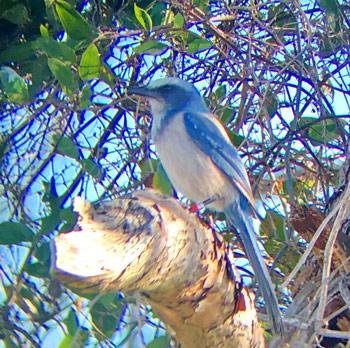
Florida Scrub-Jay in Cape Coral
|
|
|
|
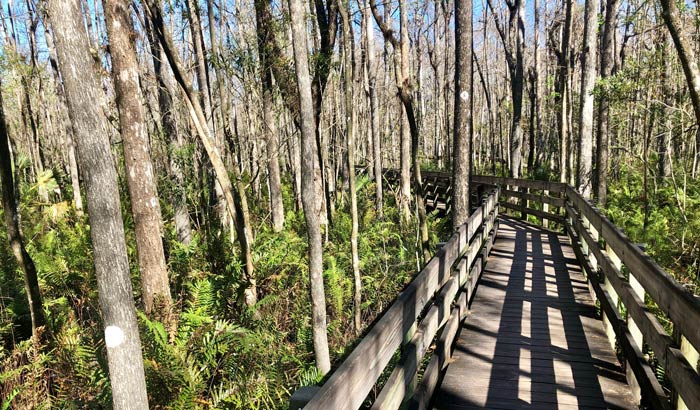
|
|
Boardwalk at Six Mile
Cypress Preserve
|
|
My final stop of the morning was in
search of Snail Kites at Six Mile Cypress Slough Preserve. There's a
really nice boardwalk that winds around the cypress preserve through
flooded and swampy areas. I dipped on the Snail Kite (in fact, I
dipped on it all week, and not for lack of trying!), but I enjoyed
the 1.5 mile walk around the boardwalk and saw lots of other cool
species such as Anhinga, Wood Stork, Northern
Parula, Palm Warbler, Tricolored Heron, and
Red-shouldered Hawk. One of the ponds has platforms out in the
middle of the pond where you can often see alligators sunning
themselves (saw one and he was quite the impressive dude, too). I
also spotted a Copperhead Snake curled up on the ground near the
boardwalk. Luckily I was several feet above him and he did not seem
inclined to worry about me in the slightest. |
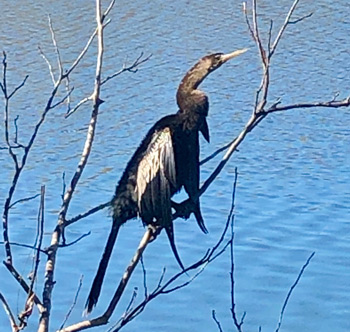
Anhinga at Six Mile Cypress Preserve |
|
Following my morning of birding
adventure I decided to go after a little mammal lifering and headed
out to the coast where I rented a paddleboard and did a little
paddling around the estuary at Lover's Key State Park. Manatees
often swim inland into the rivers and estuaries during the cold
winter months to take advantage of the warm shallow waters. I'd
heard reports they were being reported at Lover's Key and I was not
disappointed. I got to paddle quietly a few feet away from a small
group of manatees that were slowly meandering around the estuary and
it was amazing. I highly recommend the experience. Not sure anything
could top that, but I finished the day with a walk down the beach at
Lover's Key where there were Ring-billed and Laughing
Gulls, Sanderlings, one or two Lesser Black-backed
and Herring Gulls, and Willets wandering around
dodging beach goers.
The rest of the week in Florida I spent
in training but my training location was about a 10 min drive from
another birding hotspot, Harn's Marsh, which I visited a few more
time before and after training in the short daylight hours I could
grab. Harn's Marsh was a roosting site for hundreds of Black and
Turkey Vultures, and a resident Osprey that I got to
watch catching fish. It was also a great place for Limpkins,
Great Egrets, Cattle Egrets, Reddish Egrets, Tri-colored Herons,
Mottled Ducks, and Boat-tailed Grackles.
My last day in Florida I made a quick trip down to the Everglades
and took a boat tour of the 10,000 Islands Area which takes you out
through the mangrove islands. I saw probably a couple dozen
Anhinga on the road down to Everglades City along the canals
that line the road. No one else showed up for the first boat tour of
the morning, so I had a personal tour to myself which was a lot of
fun. I didn't see any new species, but there were several nesting
pairs of Osprey setting up shop and sitting on nests and lots
of Laughing Gulls, Royal Terns and Double-crested
Cormorants. Sandy beaches along the coast are also a great place
to find Wilson's Plover and other small peeps. Unfortunately
we couldn't get close enough to the islands in the large tour boat
to ID the huge flocks of peeps we saw, but it was still cool seeing
the habitat. Strangely enough there are also small populations of
raccoons that had swam out and set up camp on several of the
mangrove islands, and we saw a few of those (including a mother with
two adorable babies trailing behind her) foraging in the tide pools
along the edges of a few of the islands as well. You can pack your
camping gear into kayaks or canoes and paddle out to a few of the
islands and camp, and apparently campers on some of the islands have
had trouble with the raccoons getting into their food and fresh
water supplies and have had to come up with innovative solutions to
keep them out of their supplies. I was sad I didn't have more time
to explore the Everglades on this trip - the visitor center was
closed because of the government shut down, and I had to jet
straight back to Fort Myers for an afternoon flight. I drove past
the Florida Panther reserve on my way back north and it was exciting
to see signs that warned of caution in Panther crossing zones. On
this trip, like many others, I left with an appreciation for the
area and a wish to return to experience more of it at some point in
the future. I ended the trip with 2 lifers, putting my total life
list at 591 species (I've really gotta get south of the border!).
Happy Birding!
Keeli Marvel
|
|
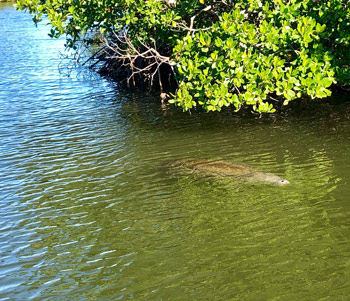
Manatee in the estuary at Lover's Key
State Park |
|
|
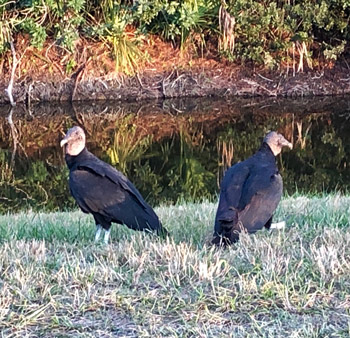
Black Vultures at Harn's Marsh |
|
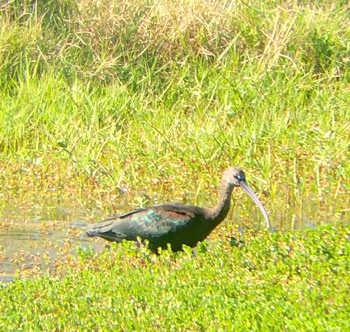
Glossy Ibis at Harn's Marsh
|
|
|
BIRD OF THE MONTH:
|
Black-headed Grosbeak
(Pheucticus melanocephalus)
by Machelle Johnson
|
This
bird is a beautiful, common bird here in Utah. We should be seeing
them arrive from Mexico during April and May. The typical habitat
includes riparian woodlands, mature pine and pine-oak forest, pinyon-juniper,
and deciduous groves, so pretty much throughout the state. You may
even see them at your feeder as they are also drawn to sugar-water and
backyard feeding stations. (They like large seeds.)
|
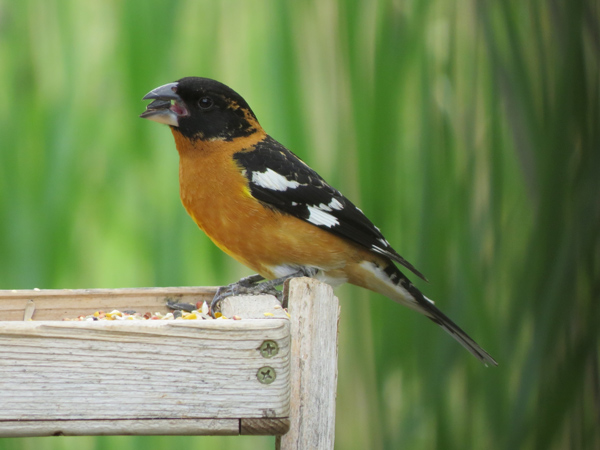 |
Male Black-headed Grosbeak
by Cliff Miles ©Cliff Miles
|
Pete Dunne describes their
appearance as: “A medium-sized, massive-headed, gargantuan-billed
songbird.” What I like most about this bird is the color, I love the
orange and black combination of the adult male. (Same colors,
different combination of Spotted Towhee and Bullock’s Oriole.) Females
and immature males are pretty easy to ID as well since they are like a
‘shadow rendering’ of the breeding male pattern, just a bit lighter,
browner and streakier.
“The scientific names, Pheucticus melanocephalus, are both
well-suited. Its species name, melanocephalus, means “black-headed”.
And it genus name, Pheucticus, refers either to the Greek pheucticus
for “shy” or phycticus meaning ‘painted with cosmetics,” fitting for a
showy bird that forages in dense foliage.”
They are slow deliberate
feeders, checking above and below their perch for insects or fruit. An
interesting note is that in winter in Mexico they feed on Monarch
butterflies. The grosbeaks are one of the butterflies few predators.
Toxins in the monarch make them poisonous to most birds, but
Black-headed Grosbeaks and a few others can eat them. They feed on
monarchs in roughly 8-day cycles, apparently to give themselves time
to eliminate the toxins.
The song consists of rising
and falling passages, resembling the American Robin’s song, but more
fluent and mellow. Call is a flat ik or eek. One description of the
song says: “In western North America, the sweet song of the
Black-headed Grosbeak caroling down from the treetops sounds like a
tipsy robin welcoming spring”. Another fact about these guys is that
both the male and female are loud songsters. The female’s song is
generally a simplified version of the male song. Occasionally though,
the female sings a full “male” song, possibly to deceive its mate
about the presence of intruders and get him to spend more time at the
nest, because the male BHGR shares nest duty in incubating eggs and
feeding young. Like she’s keeping him in line!
|
|
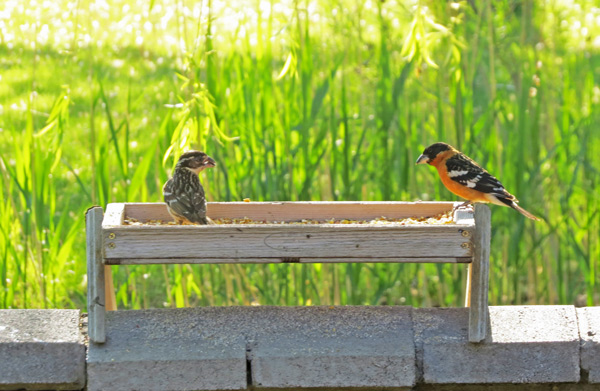 |
|
Female Black-headed
Grosbeak on the left, Male on the right
by Cliff Miles ©Cliff Miles
|
|
References:
allaboutbirds.org, Pete Dunne's Essential Field Guide Companion. |
|
|
|
|
|
|
Field Trip Reports
|
|
|
-
18 Jan 2019
Payson, Salem, Diamond Fork
Canyon
Report and Photos by
Suzi Holt
-
| We
started at the Payson Cemetery at 9:28 successfully finding 2
Barn Owls and 2 Great-horned Owls!!
|
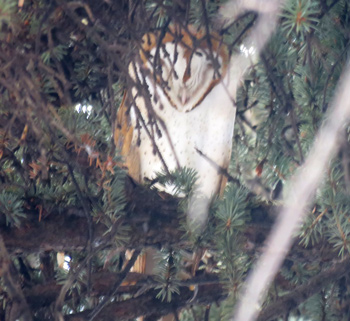 |
From there we hit Salem Pond for
the Greater Scaup pair. Check off number 3!
|
Barn Owl
|
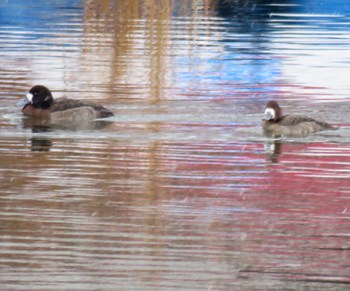 |
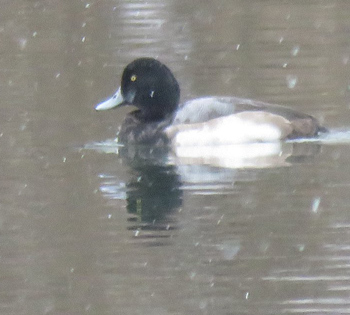 |
|
Greater Scaup & Lesser
Scaup -- females
|
Male Greater Scaup
|
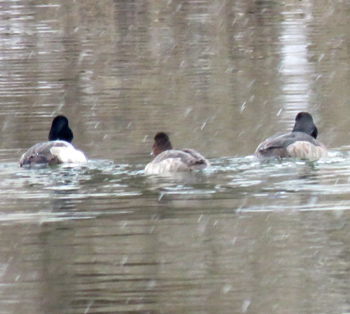 |
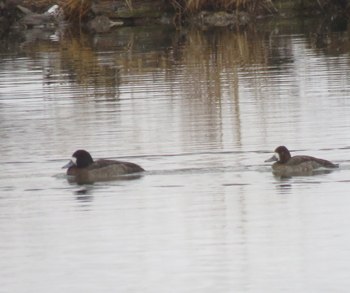 |
|
Three Scaups
|
Greater Scaup & Lesser
Scaup -- females
|
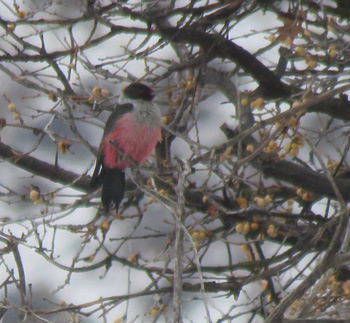 |
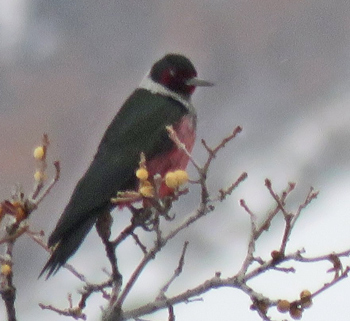 |
Stopped at the Woodland Hills Lewis's Woodpecker Hangoutt.
|
There were 3 Lewis's Woodpeckers flying
around giving us a great show!
|
| We then all piled into a few cars
at the base of SF canyon and headed up to Diamond Fork, On the way
we saw a Golden Eagle. At Diamond Fork we found Mountain
Bluebirds, a Bald Eagle, Ravens, Robins, Scrub jays,
Townsend's Solitaires, Spotted Towhees, a Canyon Wren,
Black-capped Chickadees and 3 Hermit Thrushes.
I was getting a little discouraged the
conditions were perfect for a Pygmy Owl. We had just begun to head
down the canyon when I spotted the little bugger! We all got great
looks and it was a lifer for Kaylene!. |
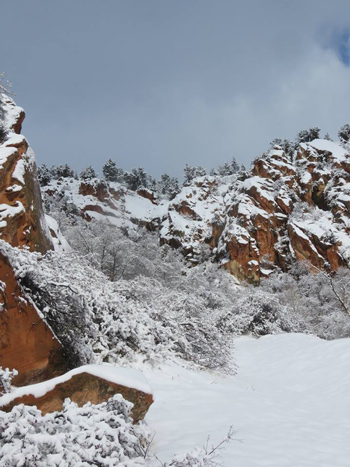 |
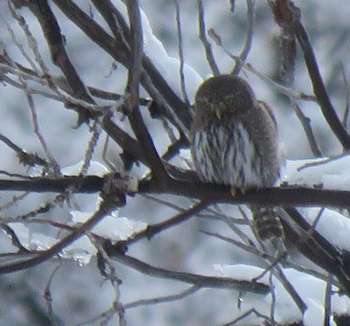 |
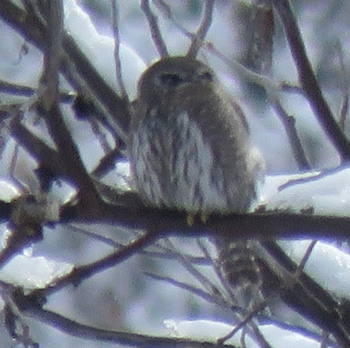 |
|
Pygmy Owl from the front
|
Pygmy Owl with "eyes" in
the back of it's head
|
We saw a couple deer and a
bunch of Wild Turkeys and called it a day.. We hit all
of our targets for the day!!! A few found one more Pygmy Owl a
little farther down. A great day for sure!! Thanks to everyone
who came!
|
|
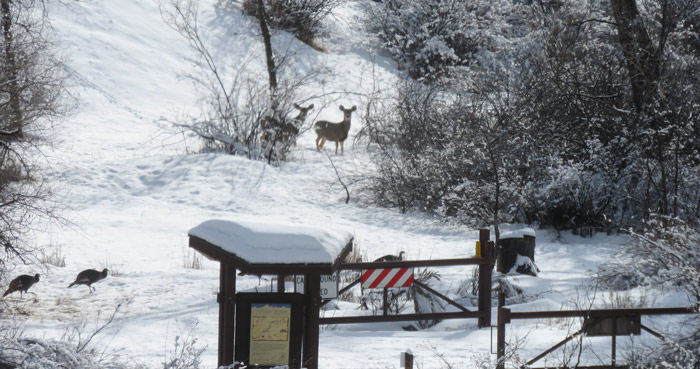 |
| |
|
|
|
|
|
-
1 Jan 2019
New Years Day
Field Trip
by Josh Kreitzer
-
We could only muster three cars of
people, but a vanguard of Utah County Birders still braved the
single-digit chill to start off the New Year with a bang.
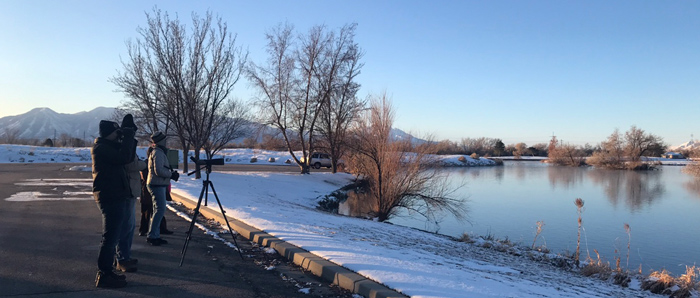 |
|
East Bay on a clear
frosty mornning, by Leena Rogers |
East Bay yielded a number of species,
including Cinnamon Teal and Rough-legged Hawk; weeven
witnessed Wood Ducks perching in a Russian Olive tree. One even
ate an olive!
A quick stop at Flowserve rewarded us with a male Hooded Merganser
and a male Belted Kingfisher.
Karen Bennett-Young's Anna's Hummingbird delighted us all, as did
a number of other firsts for the year in her neighborhood, including a
Ruby-crowned Kinglet flashing his ruby at us.
As we headed south to Woodland Hills, we passed a majestic and calm
adult Bald Eagle, perched on top of a pole right next to the
road.
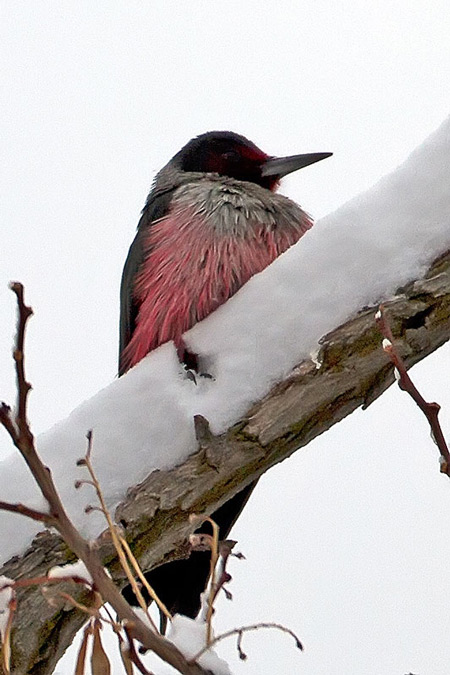 |
|
Lewis's Woodpecker
by Kendall Brown
©Kendall W. Brown
|
Two Lewis's Woodpeckers were
present at their (at least formerly) usual spot in Woodland Hills,
giving us excellent, if distant, looks as they perched on top of
telephone poles.
At Salem Pond we found Common Goldeneyes, Buffleheads, and
a small group of Lesser Scaup.
Unfortunately, Santaquin Canyon, which was covered with deep snow and
filled with snowmobilers, did not yield a single species of Zonotrichia
sparrow. :(
A quick stop at Spring Lake yielded nothing extra, so we decided to try
Payson Cemetery. At first, it was as quiet as death, though we found
many, many owl pellets under promising trees. We did come across a small
group of birds (Mountain Chickadees and House Finches, and
I briefly glimpsed a Townsend's Solitaire), but we found no owls.
By now, two of the cars had left. We remaining three birders persisted,
but we found no owls. As we headed back to our car, a young blonde boy
ran towards us, announcing that his birding party had found a Barn
Owl. Sure enough, we were able to catch a nice view of that
reclusive species high in a spruce tree.
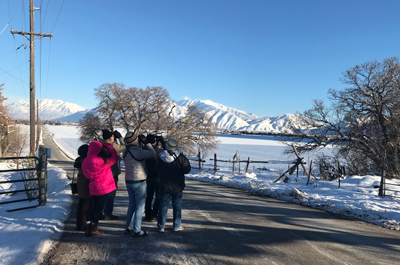 |
A
beautiful day for two Lewis's Woodpeckers
...plus a Downy,
by Leena Rogers
|
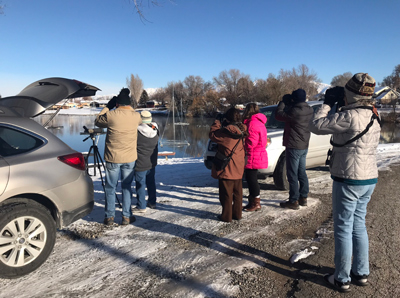 |
| Scanning
Salem Pond
by Leena Rogers |
All in all, it was a fantastic day, and though the temperature was below
freezing, the beautiful sunshine and clear sky made for a wonderful
birding adventure to begin the new year.
Here's to another wonderful year of birding!
Josh
Full species list:
43 species total, as follows: Canada Goose, Wood Duck, Gadwall, American
Wigeon, Mallard, Cinnamon Teal, Northern Shoveler, Green-winged Teal,
Lesser Scaup, Bufflehead, Common Goldeneye, Hooded Merganser,
Pied-billed Grebe, Black-crowned Night-Heron, Bald Eagle, Northern
Harrier, Cooper's Hawk, Red-tailed Hawk, Rough-legged Hawk, American
Kestrel, American Coot, Ring-billed Gull, Rock Pigeon, Eurasian
Collared-Dove, Barn Owl, Anna's Hummingbird, Belted Kingfisher, Lewis's
Woodpecker, Downy Woodpecker, Northern Flicker, Woodhouse's Scrub-Jay,
Black-billed Magpie, Black-capped Chickadee, Mountain Chickadee,
Ruby-crowned Kinglet, Townsend's Solitaire, American Robin, European
Starling, Yellow-rumped Warbler, Spotted Towhee, Red-winged Blackbird,
House Finch, and House Sparrow.
|
|
|























